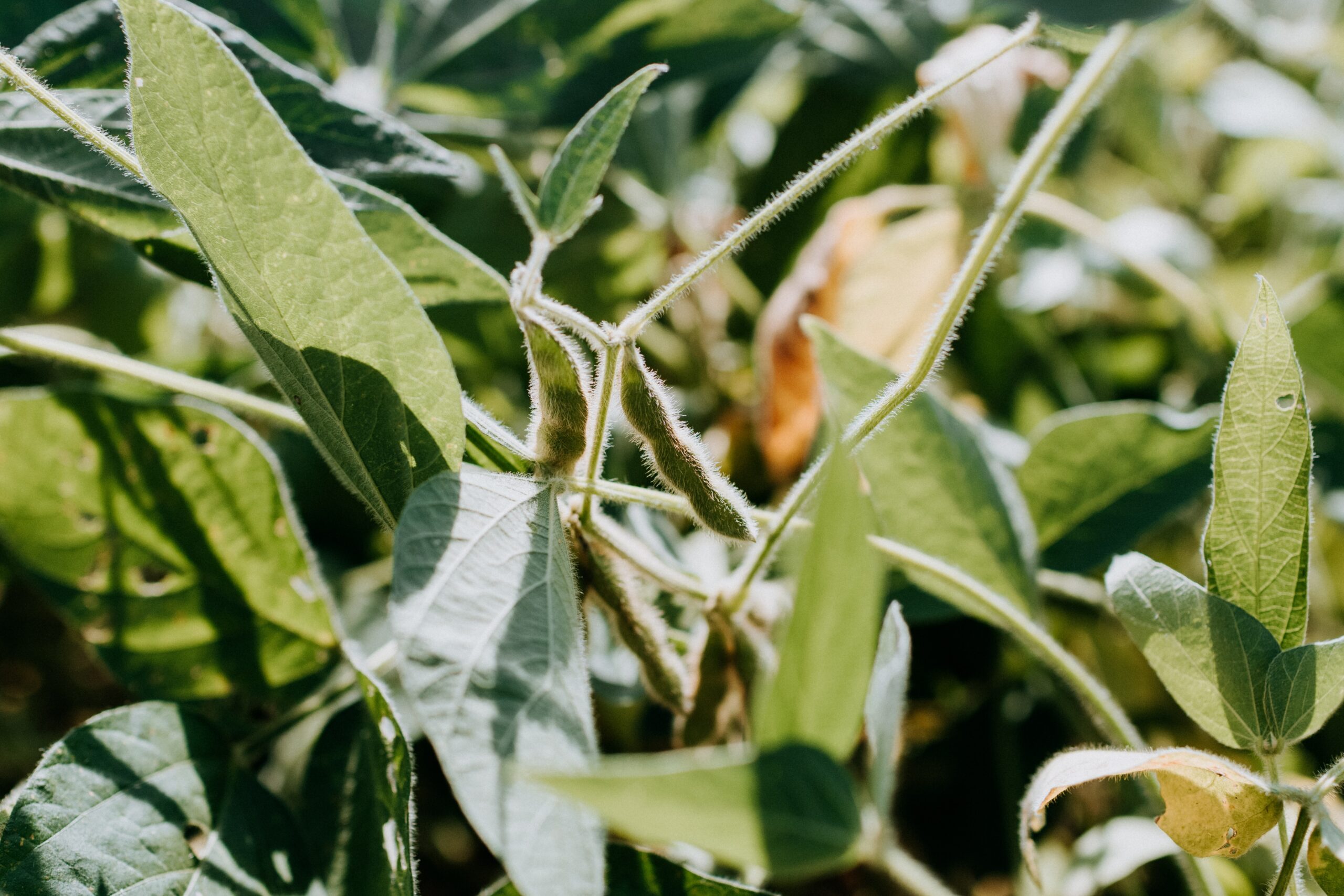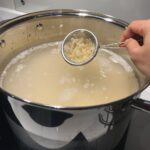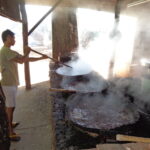(Image source: unsplash.com by Kelly Sikkema)
Soy beans
Soy beans dominate the world oilseed production and make up about 50% of the total world oilseed crop. Soy beans are the most important cash crop in the USA and the mainstay of food production in China and Japan, where it is used in various forms. South Africa has traditionally been neglected and even actively suppressed it as a cheaper protein alternative to red meat, but it is becoming more popular and is used by many maize farmers in their crop rotation programmes.
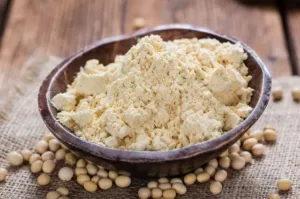
Full-fat soy flour (Image source: brookfarm.com.au)
Full-fat soy flour is prepared by grinding de-hulled soy beans. The soy beans may be given a steam treatment prior to grinding to produce toasted full-fat soy flour. Steaming inactivates the lipo
xygenase that is largely responsible for beany off-flavours. Alternatively, enzyme-active full-fat soy flour can be produced by omitting the steam treatment. The enzymes of this type of soy flour are used to bleach wheat flour and act as dough conditioners. Toasted full-fat soy flour is used in a wide range of baked products and baby formulas. It can also be further processed to produce meat substitutes through a thermoplastic extrusion process. Meat substitutes are soy products with a meat-like texture. They are prepared by mixing soy flour, water and additives to form dough. The dough is then extruded under high pressure to obtain a fibrous texture.
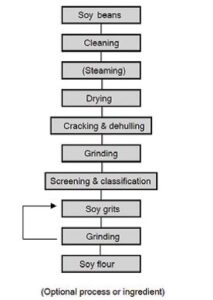
The production flow process of full-fat soy flour.
The first step in preparing the soy beans for processing is to remove foreign materials, including plant rests, stones and dust. Cleaning is performed by a series of vibrating screens followed by aspirators and cyclone separators.
Steaming of soy
beans (optional)
The soy beans are steamed under light pressure to inactivate lipoxygenase that catalyses lipid oxidation that leads to the development of off-flavours. This step may be omitted for the production of “Enzyme-active full-fat soy flour”.
Drying of soy beans
Drying prior to de-hulling is necessary to reduce the moisture content of the soy beans. A moisture content of 10% is needed to remove the hull effectively. Drying is performed by heated air that is distributed through a bed/layer of soy beans, followed by cooler air, which removes the residual moisture laden air. The dried soy beans are placed for one to five days in tempering bins where the moisture is allowed to equilibrate throughout the beans.
- Steaming soy beans (Image source: allaboutsushiguide.com)
- Different methods of steaming soy beans (Image source: ramblinbill.com)
Cracking and de-hulling of soy beans
The objective of cracking is to break the soy beans into small pieces to achieve de-hulling and to ease flaking. Corrugated or fluted rollers that rotate in opposite directions and at different speeds are used to crack the beans. Cracking rollers are generally 25 cm in diameter and at least 107 cm in length. Cracking reduces the whole soy bean into four to six fragments, loose hulls and some fines (flour particles). The fragments are sized on vibrating screens. Whole beans and large fragments are returned to the cracking rollers. The soy fragments (cotyledon) contain about 20% oil while the hull has a negligible oil content. The removal of the hulls by aspiration is optional but has the advantage of producing a defatted soy meal with a higher protein content (48% as opposed to 44% protein of flour containing hulls).
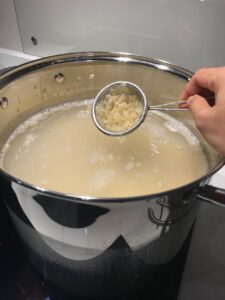
Steaming soy beans (Image source: allaboutsushiguide.com)
Grinding soy beans to produce grits
The flakes are ground by a series of rollers into smaller particles (grits) or fine flour. After each pass through the grinding rollers, the grits are screened and classified according to particle size. The coarse particles pass through a no. 10 – 20 screen, the medium particles pass through a no. 20 – 40 mesh screen and the fine particles pass through a no. 40 – 80 mesh screen. Each size class finds specific application in food products. If the grits are too big for the intended use, they are simply transferred back to the grinding rollers.
Further grinding of grits to produce soy flour
Soy flour is produced by grinding the grits into a fine powder. The flour is screened to ensure that 97% of the flour particles pass through a very fine 100 mesh screen. Because of the high lipid content, the product is difficult to screen.
Packaging of soy grits and flour
Full-fat soy grits and flour require non-transparent and moisture proof packaging. All precautions should be taken to prevent lipid oxidation.
Literature sources: Lui, KeShun. 1999. Soy beans: chemistry, technology and utilisation. Gaithersburg: Aspen Publishers, Inc.
The characteristics of soy grits and Flour
The soy bean contains approximately 40% protein and 20% oil on a moisture free basis. When soy beans were first processed commercially, the oil was considered as the most valuable component and the defatted soy bean flour as a by-product. But since 1960, the need for alternative protein sources has risen sharply across the globe. Today the flour is a highly sought after component that is mainly used in animal fodder. One metric tonne of soy beans yield approximately 180 kg oil and 800 kg flour. Soy beans have long been a major source of protein to the people of the Orient where it is consumed in various forms. The world demand for food protein is increasing sharply along with the ever rising population.
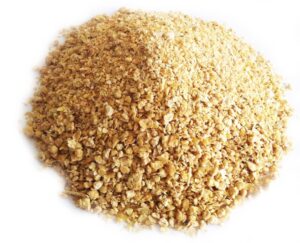
Soy grits (Image source: shreekalkaglobal.com)
Many types of soy protein products have been developed for human use from defatted soy flakes, including soy grits and flour, soy concentrate, soy isolates and textured soy proteins. Apart from economic and health advantages over animal proteins, soy proteins have more functional properties and thus a wider range of applications. It is used in virtually every food system including meat products, dairy products, baking and confectionery, breakfast cereals, infant foods and beverages. Soy grits and flour are produced from the defatted soy flakes that are separated from the miscella during oil extraction. It only requires desolventising, grinding and screening to produce a highly nutritional product with wide application possibilities in the food and feed industry.
Desolventising flakes for animal feed
The end use of the soy grits or flour determines the type of desolventising process. The method used for flakes intended for animal feed is required to remove the solvent and inactivate anti-nutritional factors such as trypsin inhibitors, thus rendering a product that is safe for animals. A steam treatment is used to remove the solvent, followed by toasting at 100°C to 105°C to ensure sufficient heat for inactivation of the toxicants. This high temperature treatment, however, also causes severe protein denaturation, which is unacceptable for products intended for human use. A different method is thus used for flakes intended for food. The hot flakes exiting from the desolventiser-toaster is dried with hot air to reduce the moisture content to 10%. Hot air is followed by cold air to cool the flakes prior to grinding.
Desolventising flakes for food
The aim of this process is to minimise the heat denaturation inflicted on the soy proteins while effectively removing the solvent. The solubility of the proteins is very important to the functional properties and use of soy proteins in food. Two types of desolventising systems van be used: the vapour system or the flash system. In
the vapour desolventising system, superheated hexane vapour is brought in contact with the flakes in agitated containers. This causes extraction of hexane from the flakes.
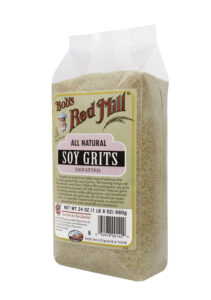
Final packaging of soy grits (Image source: bobsredmill.com)
In the flash desolventising system, superheated hexane vapour and flakes are brought in contact with each other in conveying tubes where the residence time of the flakes is kept relatively short. In both cases, desolventising is followed by deodorising. A steam unit with controlled pressure is used to deodorise the flakes. Residual solvent is also removed in the process. By controlling the conditions inside the deodorising unit, the flakes with varying protein dispersibility index (PDI) can be produced to suit the specific end use. The PDI can vary from 10 to 90%. The hot flakes exiting from the deodoriser is dried with hot air to reduce the moisture content to 10%. Hot air is followed by cold air to cool the flakes prior to grinding.
Grinding soy flakes to produce grits
The flakes are ground by a series of rollers into smaller particles (grits) or fine flour. After each pass through the grinding rollers, the grits are screened and classified according to particle size. The coarse particles pass through a 10 – 20 mesh screen, the medium particles pass through a 20 – 40 mesh screen and the fine particles pass through the 40 – 80 mesh screen. Each size class finds specific application in food products. If the grits are too big for the intended use, they are simply transferred back to the grinding rollers.
Further grinding of grits to produce soy flour
Soy flour is produced by grinding the grits into a fine powder. The flour is screened to ensure that 97% of the flour particles pass through a 100-mesh screen.
Packaging of soy grits and flour
Soy grits and flour require moisture proof packaging.
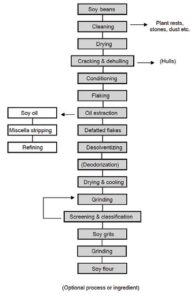
The production flow process of soy grits and flour
Uses of defatted soy grits and flour
Defatted soy flour is mainly used for animal feed, pet food and for the preparation of protein concentrates. A small quantity is used as human food. Non-food uses include the preparation of antibiotics, vitamins and other medicines.
Literature sources:
- Lui, KeShun. 1999. Soy beans: Chemistry, Technology and Utilisation. Gaithersburg: Aspen Publishers, Inc.
- Snyder, H.E. & Kwan, T.W. 1987. Soy bean Utilisation.
- Tanteeratarm, K. 1992. Soy bean Processing for Food Uses.
Published with the acknowledgement to the ARC Institute for Agricultural Engineering for the use of their manuals. Visit www.arc.agric.za for more information.

